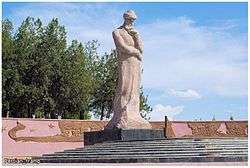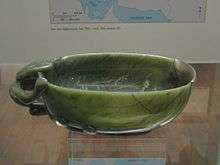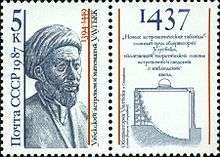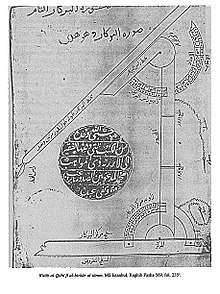Ulugh Beg
| Ulugh Beg | |
|---|---|
| Mirza (royal rank) | |
 Ulugh Beg's Statue in Samarkand, Uzbekistan | |
| Predecessor | Shahrukh Mirza |
| Successor | Abdal-Latif Mirza |
| Born |
Mirza Muhammad Tariq bin Shahrukh Mirza 22 March 1394 Sultaniyeh, Timurid Empire, Persia, now Zanjan Province, Iran |
| Died |
27 October 1449 (aged 55) Samarkand, Timurid Empire, now Samarqand Region, Uzbekistan |
| Burial | Gur-e-Amir Samarkand in the Mausoleum of Timur |
| Spouse |
Aka Begi Begum Sultan Badi al-mulk Begum Aqi Sultan Khanika Husn Nigar Khanika Shukur Bi Khanika Rukaiya Sultan Agha Mihr Sultan Agha Sa'adat Bakht Agha Daulat Sultan Agha Bakhti Bi Agha Daulat Bakht Agha Sultanim Agha Sultan Malik Agha |
| Issue | Abdal-Latif Mirza |
| Father | Shahrukh Mirza |
| Mother | Goharshad Begum |
| Religion | Islam |
| Occupation | astronomer, mathematician and sultan |
Mīrzā Muhammad Tāraghay bin Shāhrukh (Chagatay: میرزا محمد طارق بن شاہ رخ, Persian: میرزا محمد تراغای بن شاہ رخ), better known as Ulugh Beg (الغ بیگ) (March 22, 1394 in Sultaniyeh, Persia – October 27, 1449, Samarkand), was a Timurid ruler as well as an astronomer, mathematician and sultan. His commonly known name is not truly a personal name, but rather a moniker, which can be loosely translated as "Great Ruler" (compare modern Turkish ulu, "great", and bey, "chief") and is the Turkic equivalent of Timur's Perso-Arabic title Amīr-e Kabīr.[1] His real name was Mīrzā Mohammad Tāraghay bin Shāhrukh. Ulugh Beg was also notable for his work in astronomy-related mathematics, such as trigonometry and spherical geometry. He built the great Ulugh Beg Observatory in Samarkand between 1424 and 1429. It was considered by scholars to have been one of the finest observatories in the Islamic world at the time and the largest in Central Asia.[2] He built the Ulugh Beg Madrasah (1417–1420) in Samarkand and Bukhara, transforming the cities into cultural centers of learning in Central Asia.[3] He was also a mathematician of the 15th century — albeit his mental aptitude was perseverance rather than any unusual endowment of intellect.[4] His observatory is situated in Samarkand which is in Uzbekistan. He ruled Uzbekistan, Tajikistan, Turkmenistan, Kyrgyzstan, southern Kazakhstan and most of Afghanistan from 1411 to 1449.
Early life

He was a grandson of the great conqueror, Timur (Tamerlane) (1336–1405), and the oldest son of Shah Rukh, both of whom came from the Turkicized[6] Barlas tribe of Transoxiana (now Uzbekistan). His mother was a noblewoman named Goharshad, daughter of the representative Turkic[7][8] of tribal aristocracy Giyasitdin Tarhan. Ulugh Beg was born in Sultaniyeh in Persia during Timur's invasion. As a child he wandered through a substantial part of the Middle East and India as his grandfather expanded his conquests in those areas. After Timur's death, however, and the accession of Ulugh Beg's father to much of the Timurid Empire, he settled in Samarkand, which had been Timur's capital. After Shāhrukh moved the capital to Herat (in modern Afghanistan), sixteen-year-old Ulugh Beg became his governor in Samarkand in 1409. In 1411, he became the sovereign ruler of the whole Mavarannahr khanate.
Science
The teenaged ruler set out to turn the city into an intellectual center for the empire. Between 1417 and 1420, he built a madrasa ("university" or "institute") on Registan Square in Samarkand (currently in Uzbekistan), and he invited numerous Islamic astronomers and mathematicians to study there. The madrasa building still survives. Ulugh Beg's most famous pupil in astronomy was Ali Qushchi (died in 1474). He was also famous in the fields of medicine and poetry. He used to debate with other poets about contemporary social issues. He liked to debate in a poetic style, called "Bahribayt" among local poets. According to the medical book "Mashkovskiy" which is in the Russian language, Ulugh Beg discovered a mixture of alcohol with garlic, apparently preserving it to help treat conditions like diarrhea, headache, stomach ache and intestine illnesses. He also offered advice for newly married couples, which indicate recipes containing nuts, dried apricot, dried grape etc. He claimed these to be useful to increase men's virility. This recipe has been given in Ibn Sina's books also.
Astronomy
His own particular interests concentrated on astronomy, and, in 1428, he built an enormous observatory, called the Gurkhani Zij, similar to Tycho Brahe's later Uraniborg as well as Taqi al-Din's observatory in Constantinople. Lacking telescopes to work with, he increased his accuracy by increasing the length of his sextant; the so-called Fakhri sextant had a radius of about 36 meters (118 feet) and the optical separability of 180" (seconds of arc).
Using it, he compiled the 1437 Zij-i-Sultani of 994 stars, generally considered the greatest star catalogue between those of Ptolemy and Brahe, a work that stands alongside Abd al-Rahman al-Sufi's Book of Fixed Stars. The serious errors which he found in previous Arabian star catalogues (many of which had simply updated Ptolemy's work, adding the effect of precession to the longitudes) induced him to redetermine the positions of 992 fixed stars, to which he added 27 stars from Abd al-Rahman al-Sufi's catalogue Book of Fixed Stars from the year 964, which were too far south for observation from Samarkand. This catalogue, one of the most original of the Middle Ages, was first edited by Thomas Hyde at Oxford in 1665 under the title Tabulae longitudinis et latitudinis stellarum fixarum ex observatione Ulugbeighi and reprinted in 1767 by G. Sharpe. More recent editions are those by Francis Baily in 1843 in vol. xiii of the Memoirs of the Royal Astronomical Society and by Edward Ball Knobel in Ulugh Beg's Catalogue of Stars, Revised from all Persian Manuscripts Existing in Great Britain, with a Vocabulary of Persian and Arabic Words (1917).
In 1437, Ulugh Beg determined the length of the sidereal year as 365.2570370...d = 365d 6h 10m 8s (an error of +58 seconds). In his measurements over the course of many years he used a 50 m high gnomon. This value was improved by 28 seconds in 1525 by Nicolaus Copernicus, who appealed to the estimation of Thabit ibn Qurra (826–901), which had an error of +2 seconds. However, Ulugh Beg later measured another more precise value of tropical year as 365d 5h 49m 15s, which has an error of +25 seconds, making it more accurate than Copernicus's estimate which had an error of +30 seconds. Ulugh Beg also determined the Earth's axial tilt as 23°30'17" in the sexagesimal system of degrees, minutes and seconds of arc, which in decimal notation converts to 23.5047 degrees.[9]
Mathematics
In mathematics, Ulugh Beg wrote accurate trigonometric tables of sine and tangent values correct to at least eight decimal places.
Death
Ulugh Beg's scientific expertise was not matched by his skills in governance. When he heard of the death of his father Shahrukh Mirza, Ulugh Beg went to Balkh, where he heard that his nephew Ala-ud-Daulah Mirza bin Baysonqor, son of Ulugh's brother Baysonqor, had claimed the emirship of the Timurid Empire in Herat. Consequently, Ulugh Beg marched against Ala-ud-Daulah and met him in battle at Murghab. Having won this battle, Ulugh Beg advanced toward Herat and massacred its people in 1448, but Ala-ud-Daulah's brother Mirza Abul-Qasim Babur bin Baysonqor came to his aid, defeating Ulugh Beg. Ulugh Beg retreated to Balkh, where he found that its governor, his oldest son Abdal-Latif Mirza, had rebelled against him. Another civil war ensued. Within two years, he was beheaded by the order of his own eldest son while on his way to Mecca.[10] Eventually, his reputation was rehabilitated by his nephew, Abdallah Mirza (1450–1451), who placed Ulugh Beg's remains in the mausoleum of Timur in Samarkand, where they were found by archeologists in 1941.
Marriages
Ulugh Beg had thirteen wives:
- Aka Begi Begum, daughter of Muhammad Sultan Mirza bin Jahangir Mirza and Khan Sultan Khanika, mother of Habiba Sultan known as Khanzada Begum and another Khanzada Begum;
- Sultan Badi al-mulk Begum, daughter of Khalil Sultan bin Miran Shah and Shad Malik Agha;
- Aqi Sultan Khanika, daughter of Sultan Mahmud Khan Ogeday;
- Husn Nigar Khanika, daughter of Shams-i-Jahan Khan Chaghatay;Ulugh Beg Observatory in Samarkand. In Ulugh Beg's time, these walls were lined with polished marble.
- Shukur Bi Khanika, daughter of Darwish Khan Jochi;
- Rukaiya Sultan Agha, an Arlat lady, and mother of Abdal-Latif Mirza, Ak Bash Begum and Sultan Bakht Begum;
- Mihr Sultan Agha, daughter of Tukal bin Sarbuka;
- Sa'adat Bakht Agha, daughter of Bayan Kukaltash, mother of Qutlugh Turkhan Agha;
- Daulat Sultan Agha, daughter of Khawand Sa'id;
- Bakhti Bi Agha, daughter of Aka Sufi Uzbek;
- Daulat Bakht Agha, daughter of Sheikh Muhammad Barlas;
- Sultanim Agha, mother of Abdul Hamid Mirza and Abdul Jabrar Mirza;
- Sultan Malik Agha, daughter of Nasir-al-Din, mother of Ubaydullah Mirza, Abdullah Mirza and another Abdullah Mirza;

Legacy
- The crater, Ulugh Beigh, on the Moon, was named after him by the German astronomer Johann Heinrich von Mädler on his 1830 map of the Moon.
- 2439 Ulugbek, a main-belt asteroid which was discovered on 21 August 1977 by N. Chernykh at Nauchnyj, was named after him.
Exhumation
Soviet anthropologist Mikhail M. Gerasimov reconstructed the face of Ulugh Beg. Like his grandfather Timurlane, Ulugh Beg is close to the Mongoloid type with slightly Europoid features.[11][12] His father Shah Rukh, had predominantly Caucasoid features, with no obvious Mongoloid feature.
See also
- Muslim scholars
- Ulugh Beg Observatory and Museum
- Ulugh Beg Madrasa in Samarkand
Notes
- ↑ B.F. Manz, "Tīmūr Lang", in Encyclopaedia of Islam, Online Edition, 2006
- ↑ Science in Islamic civilisation: proceedings of the international symposia: "Science institutions in Islamic civilisation", & "Science and technology in the Turkish and Islamic world"
- ↑ The global built environment as a representation of realities: By author:A.J.J. Mekking
- ↑ History of mathematics. By David Eugene Smith
- ↑ British Museum Collection
- ↑ Encyclopædia Britannica, "Timur", Online Academic Edition, 2007. Quotation: "Timur was a member of the Turkicized Barlas tribe, a Mongol subgroup that had settled in Transoxania...
- ↑ В.В. Бартольд. Улугбек и его время. – Petrograd, 1918 - p. 37.
- ↑ http://www.opklare.ru/m/ulugbek_-_biografiya
- ↑ L.P.E.A. Sédillot, Prolégomènes des tables astronomiques d'OlougBeg: Traduction et commentaire (Paris: Firmin Didot Frères, 1853), pp. 87 & 253.
- ↑ Stevens, John. The history of Persia. Containing, the lives and memorable actions of its kings from the first erecting of that monarchy to this time; an exact Description of all its Dominions; a curious Account of India, China, Tartary, Kermon, Arabia, Nixabur, and the Islands of Ceylon and Timor; as also of all Cities occasionally mention'd, as Schiras, Samarkand, Bokara, &c. Manners and Customs of those People, Persian Worshippers of Fire; Plants, Beasts, Product, and Trade. With many instructive and pleasant digressions, being remarkable Stories or Passages, occasionally occurring, as Strange Burials; Burning of the Dead; Liquors of several Countries; Hunting; Fishing; Practice of Physick; famous Physicians in the East; Actions of Tamerlan, &c. To which is added, an abridgment of the lives of the kings of Harmuz, or Ormuz. The Persian history written in Arabick, by Mirkond, a famous Eastern Author that of Ormuz, by Torunxa, King of that Island, both of them translated into Spanish, by Antony Teixeira, who liv'd several Years in Persia and India; and now render'd into English.
- ↑ Greater Iran: a 20th-century odyssey. Author
- ↑ Ich suchte Gesichter. Author:Mikhail Mikhaĭlovich Gerasimov
References
- O'Connor, John J.; Robertson, Edmund F., "Ulugh Beg", MacTutor History of Mathematics archive, University of St Andrews .
- 1839. L. P. E. A. Sedillot (1808–1875). Tables astronomiques d’Oloug Beg, commentees et publiees avec le texte en regard, Tome I, 1 fascicule, Paris. A very rare work, but referenced in the Bibliographie generale de l’astronomie jusqu’en 1880, by J.
- 1847. L. P. E. A. Sedillot (1808–1875). Prolegomenes des Tables astronomiques d’Oloug Beg, publiees avec Notes et Variantes, et precedes d’une Introduction. Paris: F. Didot.
- 1853. L. P. E. A. Sedillot (1808–1875). Prolegomenes des Tables astronomiques d’Oloug Beg, traduction et commentaire. Paris.
- Le Prince Savant annexe les étoiles, Frédérique Beaupertuis-Bressand, in Samarcande 1400–1500, La cité-oasis de Tamerlan : coeur d'un Empire et d'une Renaissance, book directed by Vincent Fourniau, éditions Autrement, 1995, ISSN 1157-4488.
- L'âge d'or de l'astronomie ottomane, Antoine Gautier, in L'Astronomie, (Monthly magazine created by Camille Flammarion in 1882), December 2005, volume 119.
- L'observatoire du prince Ulugh Beg, Antoine Gautier, in L'Astronomie, (Monthly magazine created by Camille Flammarion in 1882), October 2008, volume 122.
- Le recueil de calendriers du prince timouride Ulug Beg (1394–1449), Antoine Gautier, in Le Bulletin, n° spécial Les calendriers, Institut National des Langues et Civilisations Orientales, juin 2007, pp. 117–123. d
- Jean-Marie Thiébaud, Personnages marquants d'Asie centrale, du Turkestan et de l'Ouzbékistan, Paris, éditions L'Harmattan, 2004. ISBN 2-7475-7017-7.
Further reading
| Wikisource has the text of the 1911 Encyclopædia Britannica article Ulugh Beg. |
- Dalen, Benno van (2007). "Ulugh Beg: Muḥammad Ṭaraghāy ibn Shāhrukh ibn Tīmūr". In Thomas Hockey; et al. The Biographical Encyclopedia of Astronomers. New York: Springer. pp. 1157–9. ISBN 978-0-387-31022-0. (PDF version)
External links


- The observatory and memorial museum of Ulugbek
- Bukhara Ulugbek Madrasah
- Registan the heart of ancient Samarkand.
- Biography by School of Mathematics and Statistics University of St Andrews, Scotland
- Legacy of Ulug Beg
Ulugh Beg | ||
| Preceded by Shahrukh Mirza |
Timurid Empire 1447–1449 |
Succeeded by 'Abd al-Latif |
